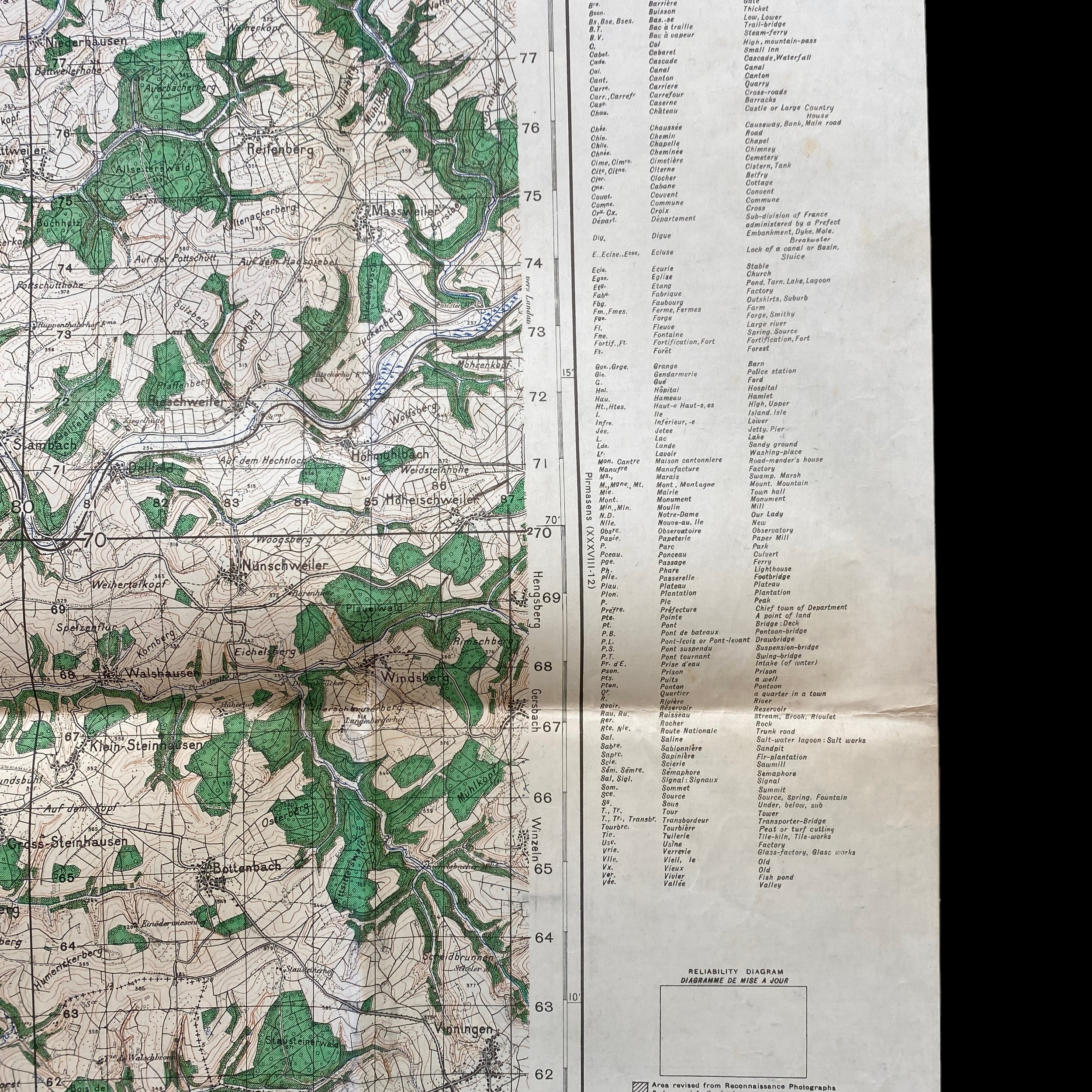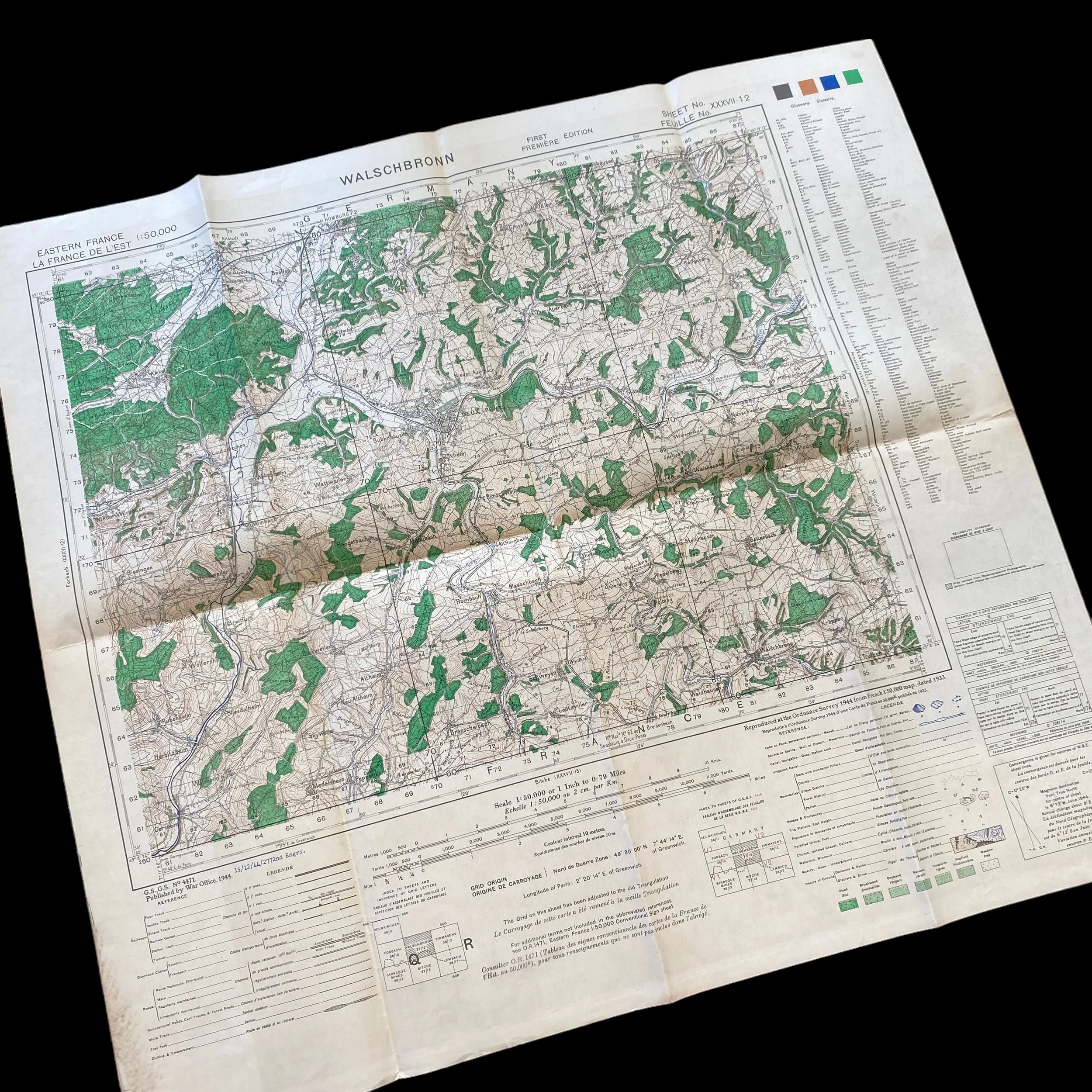WWII 1944 “Walschbronn - EASTERN FRANCE” 70th Infantry Division 276th Infantry Regiment Eastern France Combat Assault Map*








































WWII 1944 “Walschbronn - EASTERN FRANCE” 70th Infantry Division 276th Infantry Regiment Eastern France Combat Assault Map*
Comes with C.O.A.
This incredible and museum-grade WWII combat operation assault map was used by the 70th Infantry Division, 276th Infantry Regiment following the infamous BATTLE FOR FORBACH in Eastern France. This map of “Walschbronn - EASTERN FRANCE” was the adjacent map to the “Forbach - EASTERN FRANCE” sector. This was used in conjunction as the 70th Infantry Division pushed from France into Germany.
What makes this map even more rare is that it is printed on the backside of a previously used European Theater combat operations map. This was done to reuse resources on the front-lines when time and materials were limited.
Battle of Forbach:
After the liberation of Oeting, the immediate objective of the 276th Infantry was Forbach, a well defended French mining center near Saarbrucken, Germany. To reach Forbach, the Trailblazers had to overcome three imposing terrain barriers; the high ground of the Kleinwald covered by thick woods, the ancient Schlossberg Castle towering above a steep hill overlooking Forbach, and to the left of the high ground a well protected narrow valley which the GIs had to traverse. The four-hundred year old tower of Schlossberg served the enemy as an observation post from which their observers directed artillery and mortar fire against the advancing Trailblazers. Automatic weapons covered the valley nearly the entire distance between Oeting and Forbach.
On 18 February, under 88 mm artillery fire, intense machine gun fire and terrible cold rain, Companies A and C captured two hills of the Kleinwald and Companies I and L fought to positions where they would attack the castle and nearby barracks the next morning. In the late afternoon of 19 February, [see S-3 Report, 276th] after suffering many casualties, Company I had surrounded the castle, Company L had cleared the barracks and Company A gained a foothold in Forbach by capturing the Marie Madelaine Hospital. The regiment then moved into position to enter Forbach. The 1st Battalion rifle companies plus Company F were on the right, and the 3rd Battalion rifle companies plus Company E were on the left. Heavy weapons companies were in support. That night the Germans intensified their efforts to defend the city by continuous mortar and artillery bombardment of all 276th Infantry positions, including Schlossberg Castle. Small arms, mortars, potato masher grenades and panzerfausts were used against the GIs in the hospital without letup. That determined resistance, which continued all day of 20 February and into the night, held Company A at the hospital and was the Germans' last desperate attempt to drive the Trailblazers back from Forbach. Each attempt to penetrate the German defenses resulted in more wounded and dead GIs but that afternoon General Barnett ordered the Bloody Axe Regiment to attack at once and capture Forbach. "Cut, Slash and Drive!"
At 0800, 21 February, in face of intense machine gun and mortar fire, the GIs attacked, pierced the enemy defenses and broke out into the city. Slowly and methodically, they took house after house in the southeast section of town. It was a costly, bloody ordeal and the number of casualties was astounding. City fighting was a novel experience for the Trailblazers. Heretofore, their combat was in small villages, forests, and mountains. The multi-storied buildings presented much different obstacles to overcome than did the small houses such as in Wingen and Oeting. Each building was in effect a huge bunker, with small basement windows that opened at street level like pillbox embrasures. The solid stone walls varied from several inches to more than three feet thick and many could withstand the impact of 105mm artillery. The Germans knew every building, street, alley, and neighborhood square. They positioned themselves at strategic locations throughout the city where they established strong points; and with minimum manpower, they skillfully defended their lines with rifles, light mortars, burp guns and other automatic weapons. Their forward observers directed mortar and artillery fire on the advancing GIs with unbelievable accuracy.
When the men could no longer see what they were attacking, the companies made preparations to hold up for the night and defend the real estate for which they paid so dearly. The men were physically exhausted from the grueling day of storming buildings, running through and climbing over rubble, and from being on the attack for more than a week without letup. Their meager meals were K and C rations often eaten on the run. Nightfall did not present an opportunity to rest. They cleaned their weapons, changed their socks, posted sentries, and some went on patrols to locate enemy positions. The walking wounded made their way back to aid stations and the more seriously wounded were assisted by their buddies. The attack resumed at dawn 22 February when the enemy resistance increased substantially as a result of their bringing up several hundred reinforcements during the night. The line companies continued their painful building-to-building advance to the downtown area. Casualties remained high and speedy evacuation of the wounded became more difficult. In the early afternoon Company A reached the center town square where several streets, including the highway to Oeting, converged on Rue Nationale, the main east-west artery. There the enemy was well established in cellars commanding clear fields of fire down all the intersecting streets. As the GIs approached the square, they were met with a rain of machine gun bullets, sniper fire and mortar shells. The closer they got to Rue Nationale, the more intense and fierce the fighting became. The CO called for artillery and a few minutes later, 105mm shells screeched over the mens' heads and crashed into the enemy occupied buildings across the square. The shells exploded so close to the GIs that they hardly heard them going over, but they felt the concussion and the pressure on their ears. When the shelling ceased, the GIs dashed across the square, threw grenades into the buildings, and burst in with rifles blazing. After crossing Rue Nationale both battalions continued north for a few blocks to the railroad which, with its adjacent yards, appeared to be an impassible barrier. The railroad station on the south side of the main line was deserted and except for a few disabled freight cars, the yards were void of activity, but whenever anyone attempted to get near the tracks all hell broke loose. They were there waiting in strength.
Meanwhile, the 274th Infantry's advance through the forests and mountain ridges east of Forbach met vicious enemy opposition and counterattacks, consequently orders were to hold at the railroad and establish a line of defense until both regiments were on line. For the next few days the men consolidated their positions and mopped-up the last pockets of resistance south of the railroad. The fighting evolved mainly in an exchange of rifle, machine gun and mortar fire. To keep abreast of enemy activities and troop movements, reconnaissance patrols were sent out every night. Likewise German patrolling was active. Heavy artillery shells and nebelwerfers (screaming-meemies), whose blasts were horrendous, hit Forbach day and night. By 2 March the 274th Infantry had captured the mountain ridges east of Forbach, and the right flank of the 276th Infantry was no longer exposed. 3 March at 0800, in a cold rain, the Regiment attacked across the railroad with the 1st Battalion on the right and the 3rd Battalion on the left. Riflemen of the assault companies entered and captured houses in their respective sectors less than ten minutes after crossing the line of departure. In an attempt to get through an underpass, Companies K and A met small arms and automatic weapons fire from straight up the road and land mines prevented the attached tank platoon from passing through the underpass. An engineer mine platoon was summoned to clear the way for the tanks and a concentration of 240mm artillery blasted the hell out of enemy fortified positions. The heavy artillery barrage enabled the GI's to continue the perilous business of running from street to gutter to doorway, throwing hand grenades in windows and cellar embrasures, climbing and stumbling over rubble, and bursting into buildings. They attacked from door to door, building to building, and block to block to the northern edge of Forbach and on into the Forbach Forest. By that time the combat infantrymen were totally exhausted, hungry and wet from many days of close combat in the miserable cold rain. They were bruised and cut from falling in rubble and broken glass that littered the pot-holed cobblestone streets, but they pushed on toward Germany.
History of the 70th Infantry Division:
The three infantry regiments of the 70th Infantry Division, the 274th, 275th and 276th, landed at Marseille, France, 10–15 December 1944, and were formed into Task Force Herren under command of deputy division commander, Thomas W. Herren, before the arrival of the remainder of the division on 18 January 1945. Task Force Herren took over defensive positions along the west bank of the Rhine, 28 December 1944, in the vicinity of Bischwiller, south of Haguenau Forest. Elements took part in the fight to stop the German Operation Nordwind, and struck at the enemy at Philippsbourg and at Wingen between Bitche and Hagenau. In mid-January 1945, the task force moved to an area directly south of Saarbrücken, where it carried out reconnaissance and combat patrols, and improved its defensive positions.